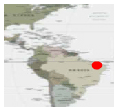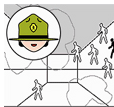|

Warren Sack and Sawad Brooks
http://www.cs.unm.edu/~sawad/walker/proposal/test.html
"While there is great hope that the Internet will one day truly be worldwide, mutual
understanding and worldwide communication cannot be accomplished simply by running
fiber optic cable across international borders. Right now on the net, discussion is
dominated by the English language. If we hope to include most of the Earth's population
in a global conversation the means will need to be found to connect people across
languages and cultures."
Translation Map by Warren Sack and Sawad Brooks will facilitate multi-lingual
communication between online environments.
For over 50 years, computer-assisted translation has been conceived as a question of decoding.
We all understand, however, that language is far more nuanced and culturally inflected simple
replacement of similar or even same meaning words. Any parsing of a text by one of the popular
translation bots will quickly show the foibles of this approach.
Sack and Brooks propose to create a piece of software that piggybacks on existing messaging
networks, such as AOL Messenger, to enable people on the network to collaboratively translate
a message piece by piece, forwarding along its pieces to others for further translation. Like
a FedEx package, the message would be trackable as it is parsed along, only instead of a
history of timed signatures, Sack and Brooks will create a visualization of its linguistic
transformations in relation to its geographic travel across the network.
In addition, in order to create a conduit for the message to travel outside digital networks,
Sack and Brooks will develop a printing protocol which would translate the "transformative
collage" of the message’s journey into a three-dimensional collage of interlocking shapes.
The 3-D collage would be representational of the overall structure of the translation, while
its component parts would be physical instantiations of its linguistic fragments, each its own
enfolded message/envelop.
Today’s computer networks are built on software protocols that are fundamentally textual.
Paradoxically, this linguistic medium of software is not only nearly undecipherable to the
layperson, but it has created radical, material transformations through these linguistic
means--computers and networks as forces of globalization. Translation Map develops an approach
to inhabit and visualize computer-based or computer-mediated language as a space or material form.
|





